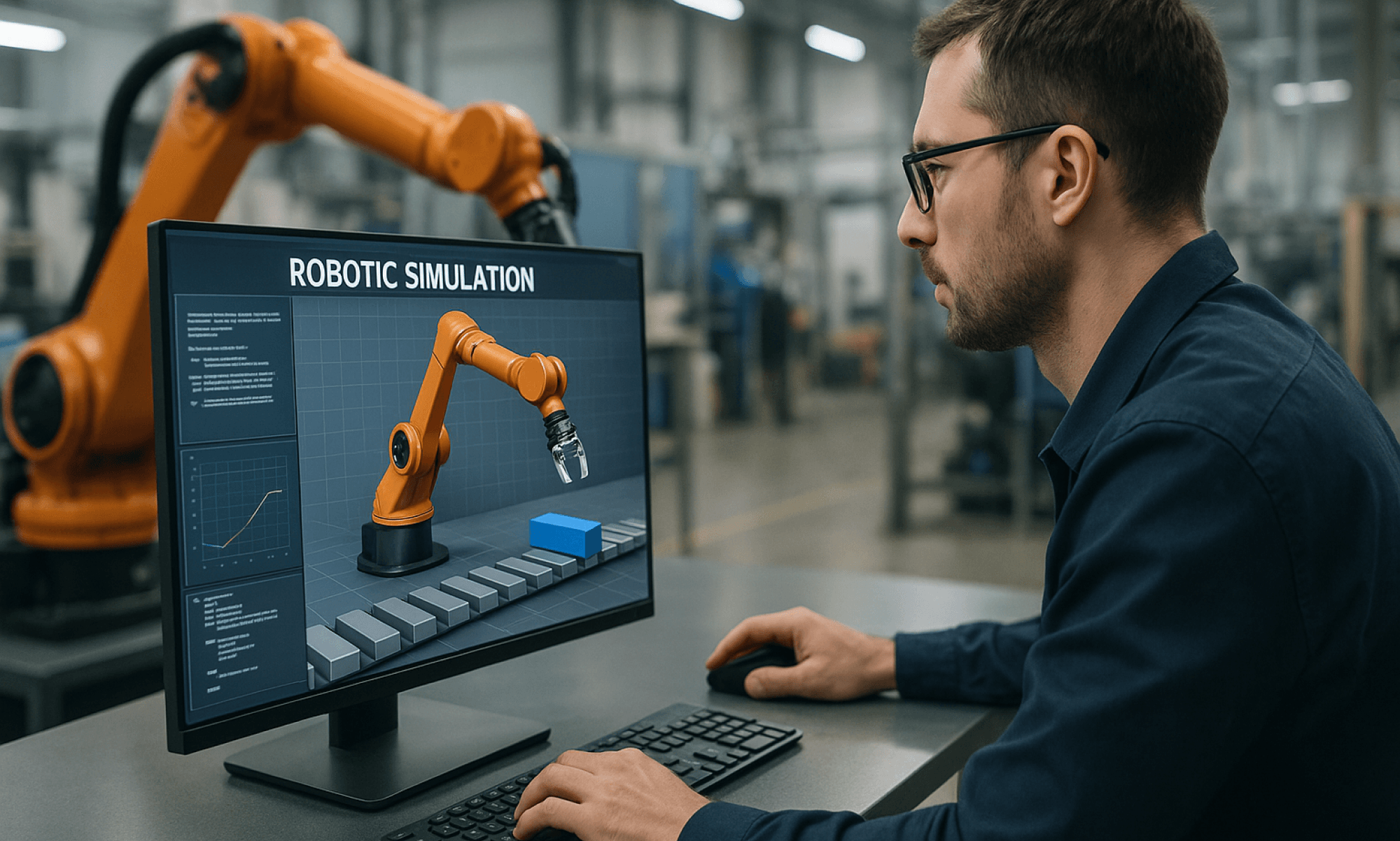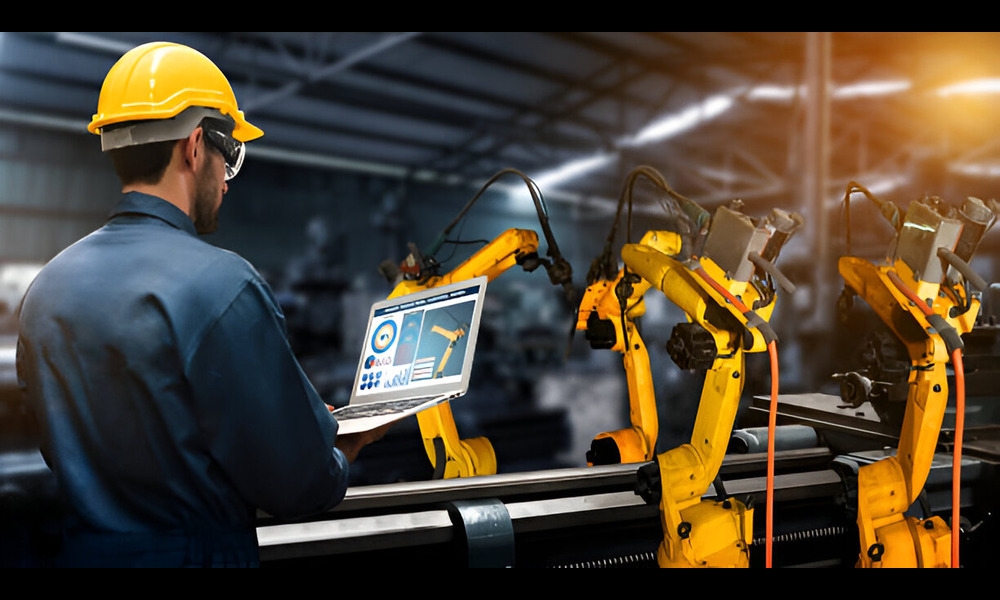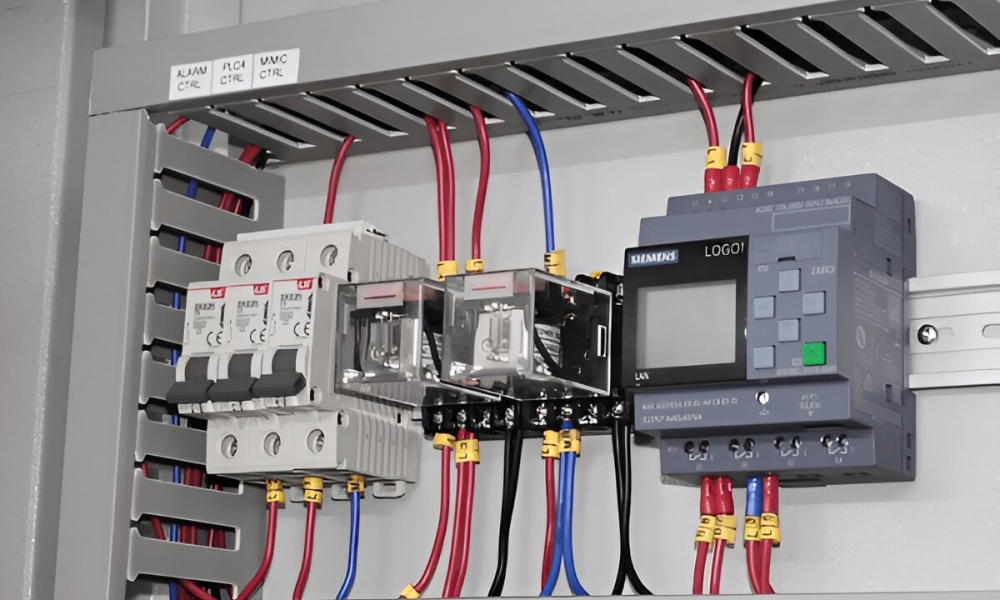Robotic simulation allows you to test and validate the performance of robots in a virtual environment that mirrors real-world conditions — without touching the shop floor.
In a typical manufacturing line, robots move, pick, place, weld, paint, assemble, or package — all in tight coordination. But how can you be sure everything will work as expected?
There are two options:
→ Build physical prototypes and test them manually. → Simulate everything virtually before manufacturing even begins.
Developing a physical prototype might look like the traditional way to test your setup. But it’s expensive, time-consuming and often limited to controlled conditions.
And what about rare or hazardous scenarios? Those are hard to recreate physically.
That’s exactly where robotic simulation stands out.
Robotic simulation lets you test everything in a virtual environment. From checking robot reach and cycle times to spotting collisions and fixing workflow issues — you can simulate it all, even under challenging or dangerous conditions.
Read further to understand:
– What is robotic simulation? – Must-have features of a good simulator – Why it’s essential in modern manufacturing – Key benefits you shouldn’t ignore
Let’s go.
What is Robotic Simulation?
Robotic simulation is a virtual testing process that optimizes automation workflows before real-world deployment.
Simulation creates a digital model of the robot and its environment, letting you check how it moves, reacts, and performs—all in a safe, risk-free space. You can iterate and validate the design, adjust control algorithms, and fix issues early, without wasting time or money on physical prototypes.
With the right simulator, you can predict and improve robot behaviour before real-world deployment. It’s faster, smarter, and way more efficient.
What is a Robot Simulator?
A robotic simulator is a software tool that lets you design, program, and test a robot in a virtual environment.
A robotic simulation software replicates the real world in 3D, including physics, sensors, and environments. This allows you to validate your robot’s movements, logic, and interactions with full control over conditions, without needing a real robot.
Engineers use it to:
– Refine control algorithms – Test sensor inputs and actuator responses – Run simulations of complex tasks (like pick-and-place, path planning, or obstacle avoidance) – Speed up development cycles
Must-have features of a good Robotic Simulator
Here are the key features a good robot simulator must have:
- Realistic Movement Simulation
A good simulator clearly shows how the robot moves in the real world, considering forces, gravity, and even collisions. This way, you can test its accuracy in handling tasks like assembly or product handling—without the risk.
- Precise Control with Inverse Kinematics (IK)
Robots need to move with pinpoint precision. IK ensures your robot reach exact positions by calculating joint movements, so you can trust it to handle tasks like assembly or pick-and-place jobs with the utmost accuracy.
- Efficient Path Planning
Think of this as the robot’s navigation system. Path planning ensures it takes the quickest, most efficient route while avoiding obstacles. This cuts down cycle times and improves overall workflow.
- CAD Integration
Robot simulators with CAD integration let you import your real designs directly. This makes testing super easy because you’re using the exact parts your robot will be working with, ensuring everything runs smoothly when you go live.
- Sensor Integration
Robots interact with the world through sensors. Whether it's cameras or force sensors, good robotic simulation software can replicate how the robot uses these sensors to understand its surroundings. This is key for making sure your robots are safe and responsive in a real-world setting.
- Real-Time Performance Tracking
Monitoring performance during testing is crucial. With this feature, you can track important details like speed and energy use, detect areas for improvement, and make sure the robot's ready to perform at its best in your factory.
- Virtual Testing Before Setup
Testing robots in a virtual version of your manufacturing line means you can spot any issues before the robot even enters the real-world environment. This saves you time, money and eliminates the headaches of trial-and-error on the factory floor.
- AI Testing
Robots are getting smarter, thanks to AI. You’ll want a simulator that can test how robots learn and adapt to new tasks. AI testing helps ensure robots can adjust to changes in your workflow and improve their performance as they go along.
Popular Robotic Simulators
Some of the most popular robot simulation software preferred in the manufacturing industry are:
– RoboDK – Siemens Process Simulate – ABB RobotStudio – Visual Components – Delmia (Dassault Systems) – KUKA Sim
Importance and benefits of Robotic Simulation in manufacturing
Robotic simulation lets engineers confirm the design is perfect before manufacturing starts. It tests the robot’s mechanical design, performance, and controls in a virtual world. This helps avoid costly mistakes and rework later.
Key benefits of Robot Simulation for industrial automation
1. Cost-Effective
Robotic simulation helps you avoid the high costs associated with physical prototypes and testing in industrial automation. By refining the robot’s design and algorithms in a virtual environment first, you save on materials, labour and most importantly, the time and the cost of trial-and-error with actual machines.
2. Risk-Free Testing
One of the most significant advantages of robot simulation is the ability to simulate dangerous or complex scenarios without any real-world risks.
For instance, testing a robot in hazardous environments, like a heavy-duty welding task or working with sharp machinery, can be done safely in the simulator. This eliminates risks to human workers and prevents equipment damage, saving time and money.
3. Improved Robotic Algorithms
In robotic development, algorithms for path planning, movement and task execution are crucial. Testing these algorithms in a safe simulated environment ensures they work correctly before you move to the physical robot.
You can fine-tune robot behaviour without worrying about breaking hardware or wasting time reprogramming in the real world. It also makes testing your automation setup much easier.
4. Faster Development
Traditional prototyping and testing can take weeks or even months. With robotic simulation, you can test and modify your designs and control systems in a fraction of the time.
Speeding up the development process means you can get robots into the work line faster, improving overall efficiency. It’s especially helpful in industries like automotive and electronics manufacturing, where time-to-market is important.
5. Improved Accuracy
Simulation tools offer a high level of precision in predicting how a robot will behave in the real world. They can predict how the robot will interact with its environment. They let you fine-tune its movement.
That way, simulations ensure the robot will function flawlessly once deployed on the factory floor.
6. Preventive Maintenance
Robotics simulation is also used to predict potential failures before they occur. By running simulations on a robot’s performance over time, you can spot wear and tear or potential breakdowns in advance.
This proactive approach lets you plan the robot’s full lifecycle and set up a maintenance schedule ahead of time. It helps you avoid surprise breakdowns and costly repairs. This further keeps your workflow smooth and your uptime high.
7. Effective Human-Robot Interaction
As robots take on more tasks alongside human workers, testing human-robot interaction (HRI) in a simulation environment is essential. You can simulate how a robot will work alongside people, whether it’s lifting heavy loads or sharing workspaces.
This ensures that robots are efficient. Plus, they are also safe to operate around humans, with built-in safety features and fail-safes.
8. Easy AI Integration
In the future, more and more robots will use AI to work smarter. With simulation, you can train and test them in a safe virtual space. Robots learn to adapt, make decisions, and handle new tasks before they ever hit the shop floor.
You can even test complex situations that are hard to recreate in real life. This kind of training helps robots perform better in the dynamic real-world environment, especially while interacting with other robots, machines or people.
What industries benefit from Robotic Simulation?
As more industries with applications in industrial automation adopt robotics, the role of robotic simulation is growing. It's now a key tool for improving efficiency, enhancing safety, and adapting to evolving challenges. Here are the top industries that benefit the most from robot simulation:
- Automotive Manufacturing: Simulation helps optimize assembly, welding and painting processes for precision and safety.
- Food and Beverage: Simulation ensures robots handle products safely while maintaining hygiene and quality.
- Aerospace: Simulation tests robotic tasks like assembly, inspection and high-precision part handling.
- Logistics and Warehousing: Simulation boosts robot efficiency in sorting, picking, and packaging.
- Healthcare: Simulation test robots for surgical accuracy and rehabilitation applications.
- Retail: Simulation improves robot performance in checkout, stocking and customer service.
- Agriculture: Simulation ensures robots adapt to environmental conditions for planting and harvesting.
- Military and Defence: Simulation tests robots for logistics, surveillance, and high-risk operations.
Robotic Simulation with Sedin Engineering
Robotic simulation is the key to faster, safer, and more cost-effective automation. Machines can be expensive to build and test. But with simulation, you can avoid costly mistakes by perfecting designs before physical deployment. It saves time, money and resources while improving overall performance.
At Sedin Engineering, we help manufacturers leverage robotics simulation to optimize automation. Contact us today to learn how we can help you reduce costs and accelerate your manufacturing processes.



